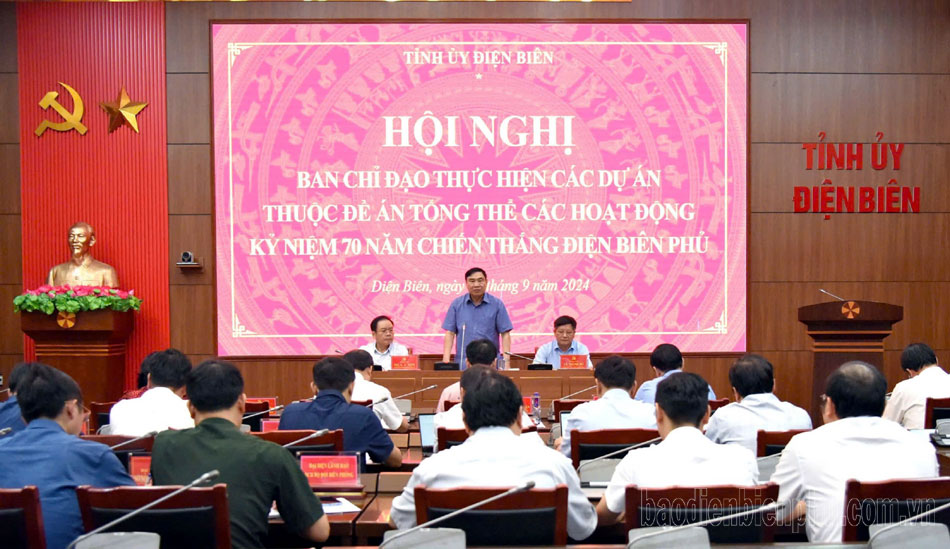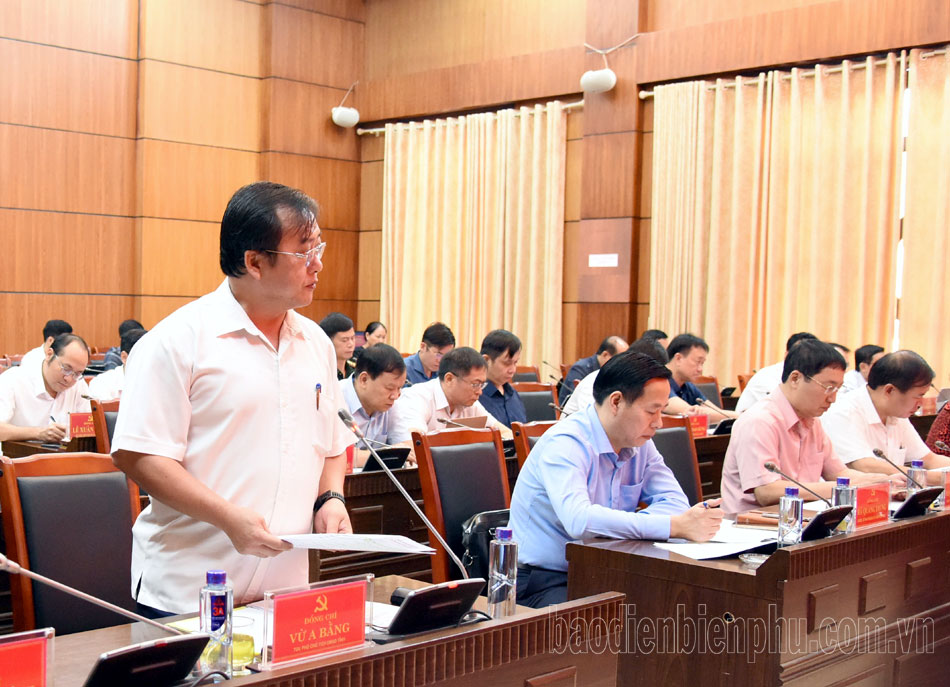Also in attendance were Mùa A Sơn, Standing Deputy Secretary of the Provincial Party Committee, and Lê Thành Đô, Deputy Secretary of the Provincial Party Committee and Chairman of the Provincial People's Committee.

Trần Quốc Cường, Member of the Central Party Committee and Secretary of the Điện Biên Provincial Party Committee delivers a speech at the meeting.
During the meeting, the Steering Committee reviewed a report from the Provincial People's Committee on the progress and results of key projects. These include the rural power supply from the national grid, preservation and restoration of the Điện Biên Phủ central fortification area, urban beautification in Điện Biên Phủ City, the Điện Biên Phủ Youth Volunteers Monument, and the second phase of the preservation of the Him Lam resistance area.
Committee members discussed various obstacles and challenges requiring resolution, shared public feedback on the projects, and agreed on timelines and implementation strategies.
Regarding the urban beautification project in Điện Biên Phủ City, two out of ten sub-projects have been completed. According to the plan, one more is expected to be finished by September 30, with the remaining seven scheduled for completion by November.
However, overall progress has been slower than anticipated due to high traffic density in urban areas where the projects are being implemented, as well as unusually prolonged rains, which have affected construction schedules.

Vừ A Bằng, Vice Chairman of the provincial People’s Committee reports on the progress of key projects.
Based on public feedback and on-site observations, Secretary of the Điện Biên Provincial Party Committee, Trần Quốc Cường, highlighted that some contractors had failed to comply with safety regulations during project implementation, leading to unsafe conditions and negatively impacting the urban landscape. He directed the People's Committee of Điện Biên Phủ City to ensure contractors set up protective barriers, install warning signs, and allocate personnel to manage traffic and ensure safety for pedestrians and vehicles, particularly during adverse weather conditions such as rain and flooding.
Regarding the rural power supply project, which aims to connect remote areas to the national power grid with a total investment of VNĐ1.26 trillion, the project is divided into seven sub-projects. Currently, investors are focused on selecting consulting units for surveys and design, following the completion of the initial design phase, and are proceeding with the necessary regulatory steps.
However, the project's large investment, the requirement for a two-step design process for these Group B projects, and the extensive scope—covering remote and mountainous areas—have made the preparatory procedures time-consuming. Additionally, the pressure to disburse funds has posed significant challenges to the project's implementation.
Commenting on the project, Secretary Trần Quốc Cường urged local authorities and relevant departments to ensure the maximum disbursement of allocated funds, stressing the importance of avoiding any capital stagnation. He highlighted the need for proactive coordination and regular progress updates, with prompt reporting to the Steering Committee for timely feedback and guidance.
For districts and towns where projects are underway, Cường emphasised strict adherence to legal regulations, advising caution and thoroughness while avoiding any rush. He also encouraged mobilising resources to expedite project evaluation and commence construction as early as possible.

Nguyễn Minh Phú, Director of the provincial Department of Culture, Sports and Tourism speaks at the meeting.
To ensure the optimal use of allocated funds within the required timeframes, Secretary Cường recommended that local authorities prioritise projects along easily accessible routes to prevent wasteful spending. He emphasised not only economic efficiency but also the importance of considering social impact, particularly by using investment resources to create local job opportunities.
Regarding the restoration and preservation of historical sites, where coordination with various central ministries and departments has limited progress primarily to the restoration of green spaces, Cường proposed reallocating funds from these projects to prioritise investment in the power supply projects.





.jpg)




.jpg)

.jpg)
.jpg)
.jpg)
.jpg)
.jpg)
.jpg)
.jpg)
.jpg)
.jpg)
You have 500/500 characters left
Please enter 5 or more characters!!!